The Christ Church Stories - Part One, Episode 2: Our First Church Growth the Old-Fashioned Way
We've Got Room for You - Part One - Episode 2
Our First Sunday
Church Growth The Old-Fashioned Way
I mentioned last time that we began services on August 4th, 1985. It was a very interesting day for me in more ways than one.
First of all, I had no idea who would come. I had called everybody I knew. I had sent word to the Diocese of Dallas, announcing that we would be opening our Sunday morning service at Carpenter Middle School, and I prayed they might send a few representatives or ambassadors to show support. We’d even put out yard signs in front of a few homes, inviting neighbors to join us. I had knocked on dozens of doors and followed up with a weekly newsletter, doing everything I could to spread the word.
Announcing the opening service felt urgent. We needed a critical mass—some visible sign that something real was beginning. We had even prayed, specifically and boldly, for 250 people to attend.
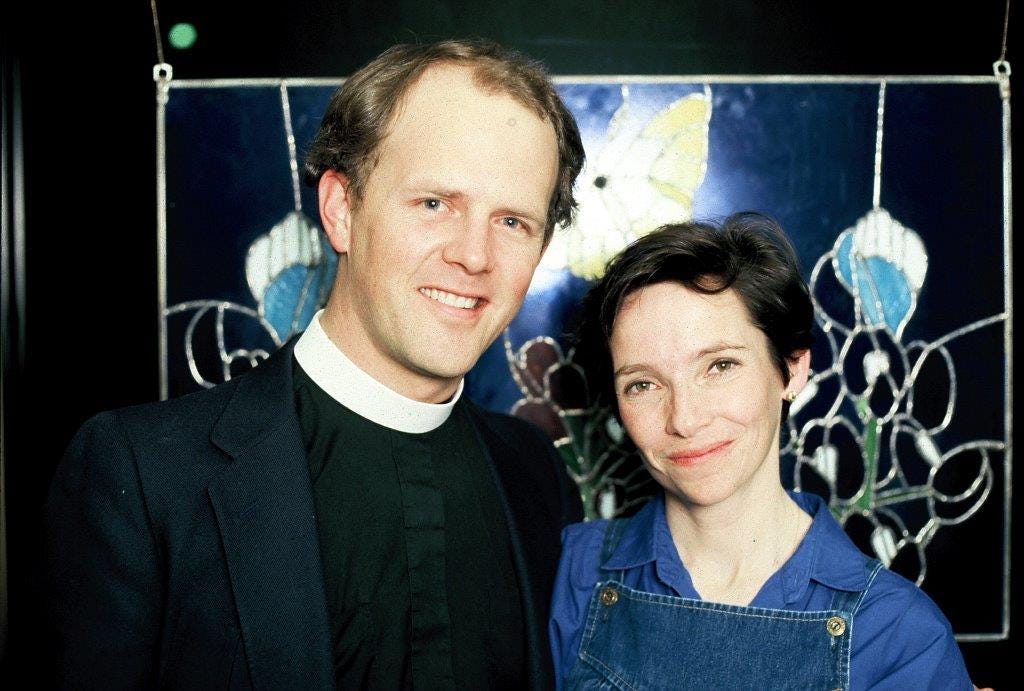
A Marked Man
The night before, Fran and I were lying in bed watching television. Jed and Taye were beside us. Daniel hadn’t been born yet, but someone had already given us a baby rattle — the kind with a suction cup that sticks to a high chair tray. I started absentmindedly playing with it, just goofing off to make the kids laugh. Without thinking, I pressed it to my forehead.
It stuck.
And when I tried to pull it off, it wouldn’t budge. We finally wedged it loose, and when we did, Fran looked at me and burst into laughter. Right in the middle of my forehead was a giant, bright red, perfectly round suction mark. A hickey.
So there I was, on the eve of launching Christ Church, with a blemish squarely —or more accurately, roundly— on my face. Not what I had imagined.
The following day, I dressed carefully — black clergy shirt, white collar, sport coat — and yes, Fran’s makeup. That’s how the founding rector of the newly minted Christ Church began his ministry: with a bit of concealer, a hopeful prayer, and a lot of nervous energy.
Foundations for the Future
Beneath the humor was something very real. I was nervous and focused — not just to have a successful launch, but to build a church that mattered. A church that was faithful. A church that would last. And so we laid four foundational stones:
First, Anglican worship.
We believed in the beauty, reverence, and rhythm of the Anglican liturgy — not as a museum piece, but as living acts of praise. Worship was the heartbeat. It wasn’t a performance. It was the gathered people of God, kneeling, singing, confessing, and receiving. I was raised in a very ‘high-church’ church in Nogales. I wanted reverence, for sure. But simplicity, too.
Second, biblical preaching.
Not self-help sermons or clever talks, but preaching that took the text seriously and exalted Christ. We believed the Word of God could speak into every human heart, not because of the preacher’s gifts, but because of the Spirit’s power. Personally, I was on a mission to become a skilled preacher who understood the Bible. I devoured the sermons of David Martyn Lloyd-Jones and John Stott. I found their biblical worldview to be coherent and completely relevant.
Third, lay ministry.
We would not be a church built on the talents of a few. We were building a place where everyone had a part to play. From day one, we trained, released, and trusted the laity to serve, lead, pray, and build the Body. Our staff would grow, but not because I hired ordained clergy, but because I found laypeople willing and eager to do the work of the church.
Fourth, small groups.
From the start, I believed true transformation occurs when someone encounters the Bible, especially within a small group community. That’s what was happening to me! Sundays were necessary, of course. A church that didn’t meet on Sunday wasn’t a church! But small group interactions and connections in living rooms were also crucial.
Where did I get these ideas? Simple. I stole them. They were an amalgamation of things I had seen in other churches. I looked to St. Stephen’s Church in Sewickley, PA, for its preaching and lay emphasis. We were in the Episcopal Diocese of Dallas, which was very ceremonial and high-church, but we dialed that back down—simple, reverent, and understandable worship. And our small group efforts were taken from Intervarsity Press and Fuller Institute.
That was the plan. And the Lord blessed it.
Compassion: The Real Secret
We grew. And we grew rapidly. By February, we were tipping into the 250 range for our average Sunday attendance.
Plano was ready for a church like this. The timing was providential. I was young enough to work with the personal energy required by the task. Fran had the heart to love the people God sent us. She was (and is) amazing. And there was something exciting about joining something on the ground floor.
But it wasn’t just the place or the time. It wasn’t just leadership or strategy. It was the people.
Christ Church grew because its people were engaged. It was like a movement. They were proud of their church and invited others to come.
Every member took a yard sign and used it in their neighborhood. The motto we developed wasn’t theological. “Discover the Miracle” didn’t refer to something conceptual or theological. It meant the miracle of the church, Christ Church—the miracle of what was happening at Christ Church.
Discover the place where strangers were becoming friends in a community of faith.
Our members believed in what was happening—and more importantly, they loved the people who lived around them enough to share it and invite them to “discover” it.
They had compassion.
I learned this lesson and teach it whenever possible:
compassion turns members into ambassadors.
The Shadow of Christ
Ralph Waldo Emerson, not a Christian but a sharp observer, once said,
“An institution is the lengthened shadow of one man.”
In the church’s case, that man is Jesus Christ.
And the shadow He cast was one of deep compassion—for the lost, the weary, the overlooked. Plano was filling up with people transplanted here from somewhere else. And when they arrived in this expanding suburb, they didn’t know a soul.
Houses were built with alleyways in the back. Most everyone had a rear-entry garage, and they would come and go every day and never meet the people living right next to them or across the street.
I’m sure some suburb planning engineer thought this was a good idea—it keeps cars off the curbs and makes for a cleaner look. But that’s the problem. It’s a clean look. It’s an appearance. People didn’t know their neighbors.
I felt a church could be one of the ONLY places in a community where people could meet, make friends, and help each other. I touched on this human need often in my preaching and teaching. People needed to love and be loved.
Jesus didn’t just talk about love. He embodied it. His heart moved for the harassed and helpless. He felt something for them. He was moved by the sick, the blind, the outcast, and the ashamed.
That’s the kind of compassion that changed the world. That’s the kind of compassion He wanted in His followers. The early church took hold of that, and when the Church is at its best, it still exhibits that kind of compassion.
Our people in those early days had that kind of heart for others.
They felt compassion for the folks they lived next to, worked with, and bumped into at the kids’ PTA or grocery store. They sensed the burdens others were carrying, and they wanted to share the peace they’d found.
That’s why we grew.
It was not because I worked hard (though I did) or because we had clever strategies (we didn’t).
We grew because our people felt what Christ felt.
They looked out, saw the harassed and helpless, and invited them to come and see what was going on at Christ Church.
A Pew on Wheels
And we were sometimes creative. On July 4th of one of our early years, we made a “float” for the parade: an old pew bought from a shuttered church, fitted with wheels and proudly displaying what became our motto for those early years.
We gathered at Carpenter Middle School for worship on Sunday mornings, and I rented office space for staff meetings. But our church met in dozens of living rooms across town. By the end of our first year, we had five small groups meeting in homes around town, which grew to ten within the next 12 months.
Simple. Effective. Lay-driven. And always open to new people joining.
We said it again and again:
We’ve got room for you.
And we meant it.
Next time on The Christ Church Stories: Selling Insurance and Building a Staff
The Anglican is the Substack newsletter for LeaderWorks, where I share insights, encouragement, and practical tools for clergy and lay Christians. I’m also an author of over a dozen books available on Amazon.
If you are a Paid Subscriber, thank you! Thank you for supporting The Anglican and the ministry of LeaderWorks. If you are not a subscriber, please consider becoming one today.






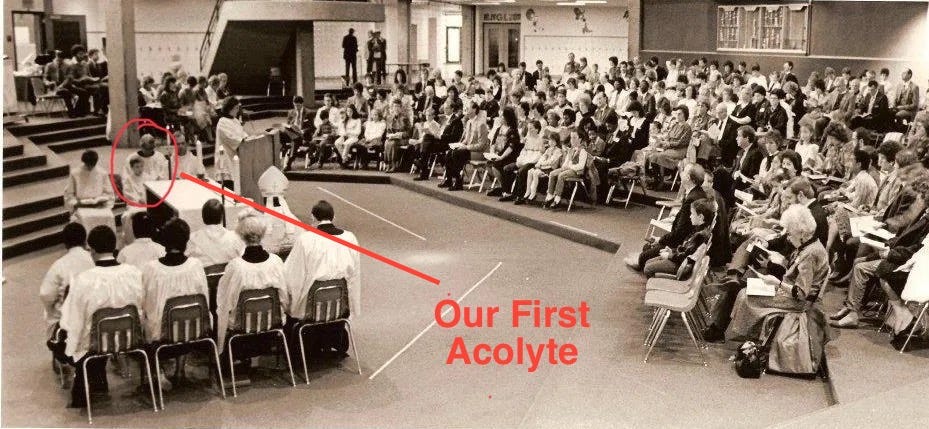
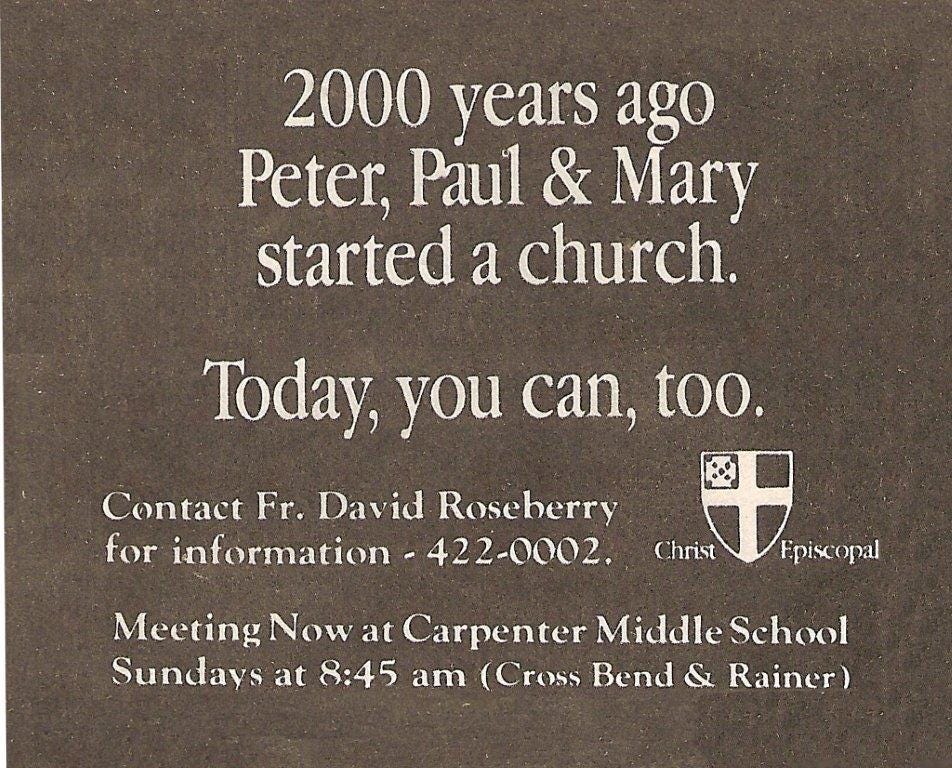
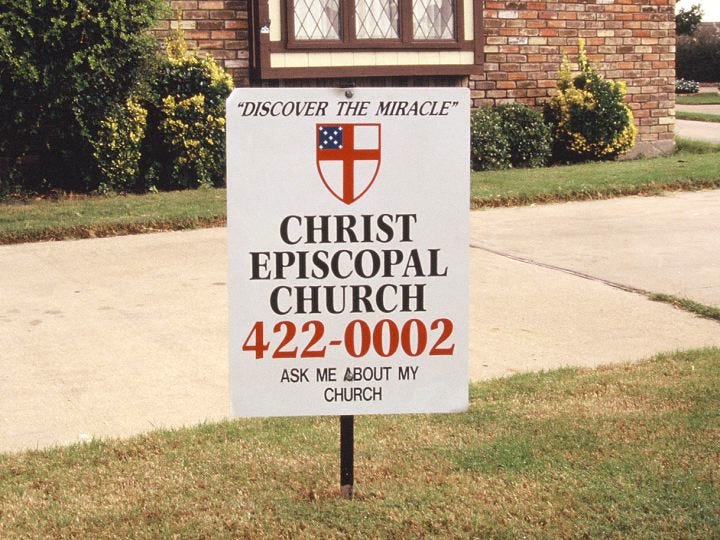
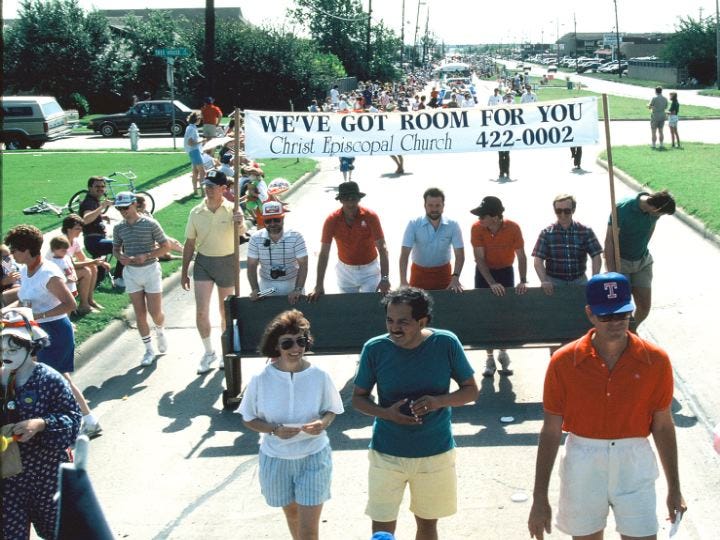
As soon as I saw "We've Got Room for You" I knew that photo would be here. As you and some others know - that is me, second from the right, pushing the pew up Independence Parkway on July 4 (the once-skinny guy in the red shirt). We did pew tricks at big intersections. And it caught everyone's attention. The rolling pew so captures the out-of-the-box thinking that helped bring the Gospel to so many!
And that photo from the Plano Star-Courier ad. The Sunday before we visited Christ Church, we had visited Holy Nativity Church in East Plano. We enjoyed the service, the people were warm and friendly, and I thought we should settle there. But my wife saw that photo ad and said, "This looks like a church we should try before we make up our minds." As ever, she got it right!
Remember the color dots on the visitor name tags? Red dot = first time visitor. Treat it like a red light: STOP, and talk to the person! Yellow dots for 2nd and onward visitors, not exactly like a yellow light (which usually means "go faster for a moment").
These stories are exciting to read, especially as someone who has been involved in church planting. Your writing also reminds me of things our team missed back in the late 80s and early '90s. We emphasized study and apologetics, which have value, but I think we over-intellectualized the message and lost the beauty and simplicity. And I think I used apologetics to protect myself from appearing naive or simplistic. So, from the get-go, I was not loving in an open-hearted, vulnerable way. I was not emphasizing compassion, of which you wrote: "Our members loved the people who lived around them enough to share it and invite them to 'discover' it." To this day, I still find that fear sometimes smothers my compassion. Thank you for the freshness of these stories!